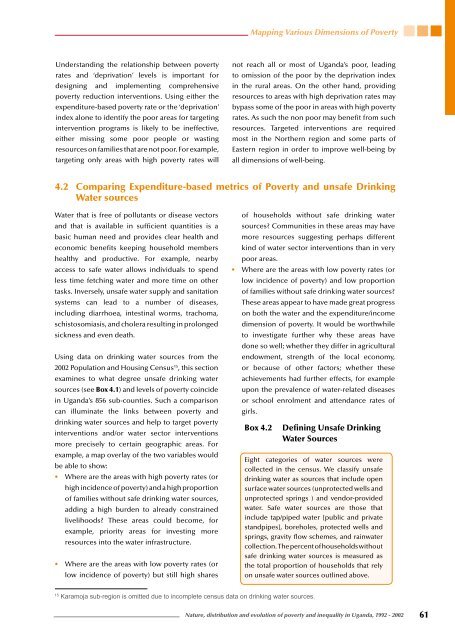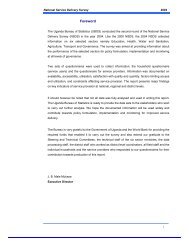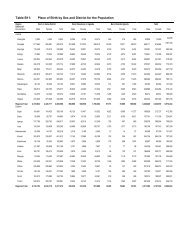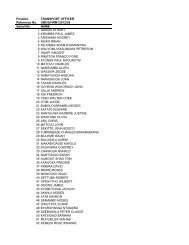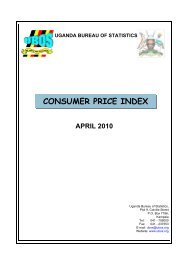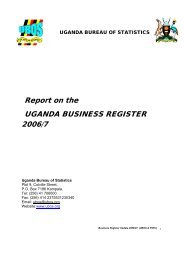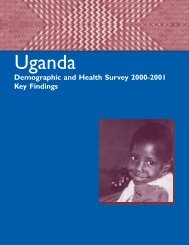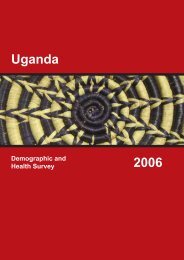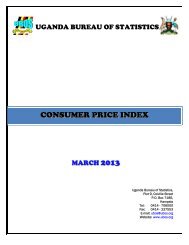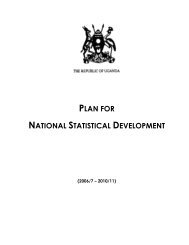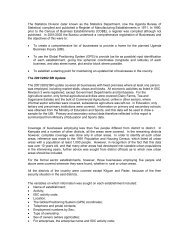Nature, Distribution and Evolution of Poverty & Inequality in Uganda
Nature, Distribution and Evolution of Poverty & Inequality in Uganda
Nature, Distribution and Evolution of Poverty & Inequality in Uganda
- No tags were found...
You also want an ePaper? Increase the reach of your titles
YUMPU automatically turns print PDFs into web optimized ePapers that Google loves.
Mapp<strong>in</strong>g Various Dimensions <strong>of</strong> <strong>Poverty</strong>Underst<strong>and</strong><strong>in</strong>g the relationship between povertyrates <strong>and</strong> ‘deprivation’ levels is important fordesign<strong>in</strong>g <strong>and</strong> implement<strong>in</strong>g comprehensivepoverty reduction <strong>in</strong>terventions. Us<strong>in</strong>g either theexpenditure-based poverty rate or the ‘deprivation’<strong>in</strong>dex alone to identify the poor areas for target<strong>in</strong>g<strong>in</strong>tervention programs is likely to be <strong>in</strong>effective,either miss<strong>in</strong>g some poor people or wast<strong>in</strong>gresources on families that are not poor. For example,target<strong>in</strong>g only areas with high poverty rates willnot reach all or most <strong>of</strong> Ug<strong>and</strong>a’s poor, lead<strong>in</strong>gto omission <strong>of</strong> the poor by the deprivation <strong>in</strong>dex<strong>in</strong> the rural areas. On the other h<strong>and</strong>, provid<strong>in</strong>gresources to areas with high deprivation rates maybypass some <strong>of</strong> the poor <strong>in</strong> areas with high povertyrates. As such the non poor may benefit from suchresources. Targeted <strong>in</strong>terventions are requiredmost <strong>in</strong> the Northern region <strong>and</strong> some parts <strong>of</strong>Eastern region <strong>in</strong> order to improve well-be<strong>in</strong>g byall dimensions <strong>of</strong> well-be<strong>in</strong>g.4.2 Compar<strong>in</strong>g Expenditure-based metrics <strong>of</strong> <strong>Poverty</strong> <strong>and</strong> unsafe Dr<strong>in</strong>k<strong>in</strong>gWater sourcesWater that is free <strong>of</strong> pollutants or disease vectors<strong>and</strong> that is available <strong>in</strong> sufficient quantities is abasic human need <strong>and</strong> provides clear health <strong>and</strong>economic benefits keep<strong>in</strong>g household membershealthy <strong>and</strong> productive. For example, nearbyaccess to safe water allows <strong>in</strong>dividuals to spendless time fetch<strong>in</strong>g water <strong>and</strong> more time on othertasks. Inversely, unsafe water supply <strong>and</strong> sanitationsystems can lead to a number <strong>of</strong> diseases,<strong>in</strong>clud<strong>in</strong>g diarrhoea, <strong>in</strong>test<strong>in</strong>al worms, trachoma,schistosomiasis, <strong>and</strong> cholera result<strong>in</strong>g <strong>in</strong> prolongedsickness <strong>and</strong> even death.Us<strong>in</strong>g data on dr<strong>in</strong>k<strong>in</strong>g water sources from the2002 Population <strong>and</strong> Hous<strong>in</strong>g Census 15 , this sectionexam<strong>in</strong>es to what degree unsafe dr<strong>in</strong>k<strong>in</strong>g watersources (see Box 4.1) <strong>and</strong> levels <strong>of</strong> poverty co<strong>in</strong>cide<strong>in</strong> Ug<strong>and</strong>a’s 856 sub-counties. Such a comparisoncan illum<strong>in</strong>ate the l<strong>in</strong>ks between poverty <strong>and</strong>dr<strong>in</strong>k<strong>in</strong>g water sources <strong>and</strong> help to target poverty<strong>in</strong>terventions <strong>and</strong>/or water sector <strong>in</strong>terventionsmore precisely to certa<strong>in</strong> geographic areas. Forexample, a map overlay <strong>of</strong> the two variables wouldbe able to show:• Where are the areas with high poverty rates (orhigh <strong>in</strong>cidence <strong>of</strong> poverty) <strong>and</strong> a high proportion<strong>of</strong> families without safe dr<strong>in</strong>k<strong>in</strong>g water sources,add<strong>in</strong>g a high burden to already constra<strong>in</strong>edlivelihoods? These areas could become, forexample, priority areas for <strong>in</strong>vest<strong>in</strong>g moreresources <strong>in</strong>to the water <strong>in</strong>frastructure.• Where are the areas with low poverty rates (orlow <strong>in</strong>cidence <strong>of</strong> poverty) but still high shares<strong>of</strong> households without safe dr<strong>in</strong>k<strong>in</strong>g watersources? Communities <strong>in</strong> these areas may havemore resources suggest<strong>in</strong>g perhaps differentk<strong>in</strong>d <strong>of</strong> water sector <strong>in</strong>terventions than <strong>in</strong> verypoor areas.• Where are the areas with low poverty rates (orlow <strong>in</strong>cidence <strong>of</strong> poverty) <strong>and</strong> low proportion<strong>of</strong> families without safe dr<strong>in</strong>k<strong>in</strong>g water sources?These areas appear to have made great progresson both the water <strong>and</strong> the expenditure/<strong>in</strong>comedimension <strong>of</strong> poverty. It would be worthwhileto <strong>in</strong>vestigate further why these areas havedone so well; whether they differ <strong>in</strong> agriculturalendowment, strength <strong>of</strong> the local economy,or because <strong>of</strong> other factors; whether theseachievements had further effects, for exampleupon the prevalence <strong>of</strong> water-related diseasesor school enrolment <strong>and</strong> attendance rates <strong>of</strong>girls.Box 4.2Def<strong>in</strong><strong>in</strong>g Unsafe Dr<strong>in</strong>k<strong>in</strong>gWater SourcesEight categories <strong>of</strong> water sources werecollected <strong>in</strong> the census. We classify unsafedr<strong>in</strong>k<strong>in</strong>g water as sources that <strong>in</strong>clude opensurface water sources (unprotected wells <strong>and</strong>unprotected spr<strong>in</strong>gs ) <strong>and</strong> vendor-providedwater. Safe water sources are those that<strong>in</strong>clude tap/piped water [public <strong>and</strong> privatest<strong>and</strong>pipes], boreholes, protected wells <strong>and</strong>spr<strong>in</strong>gs, gravity flow schemes, <strong>and</strong> ra<strong>in</strong>watercollection. The percent <strong>of</strong> households withoutsafe dr<strong>in</strong>k<strong>in</strong>g water sources is measured asthe total proportion <strong>of</strong> households that relyon unsafe water sources outl<strong>in</strong>ed above.15Karamoja sub-region is omitted due to <strong>in</strong>complete census data on dr<strong>in</strong>k<strong>in</strong>g water sources.<strong>Nature</strong>, distribution <strong>and</strong> evolution <strong>of</strong> poverty <strong>and</strong> <strong>in</strong>equality <strong>in</strong> Ug<strong>and</strong>a, 1992 - 2002 61


